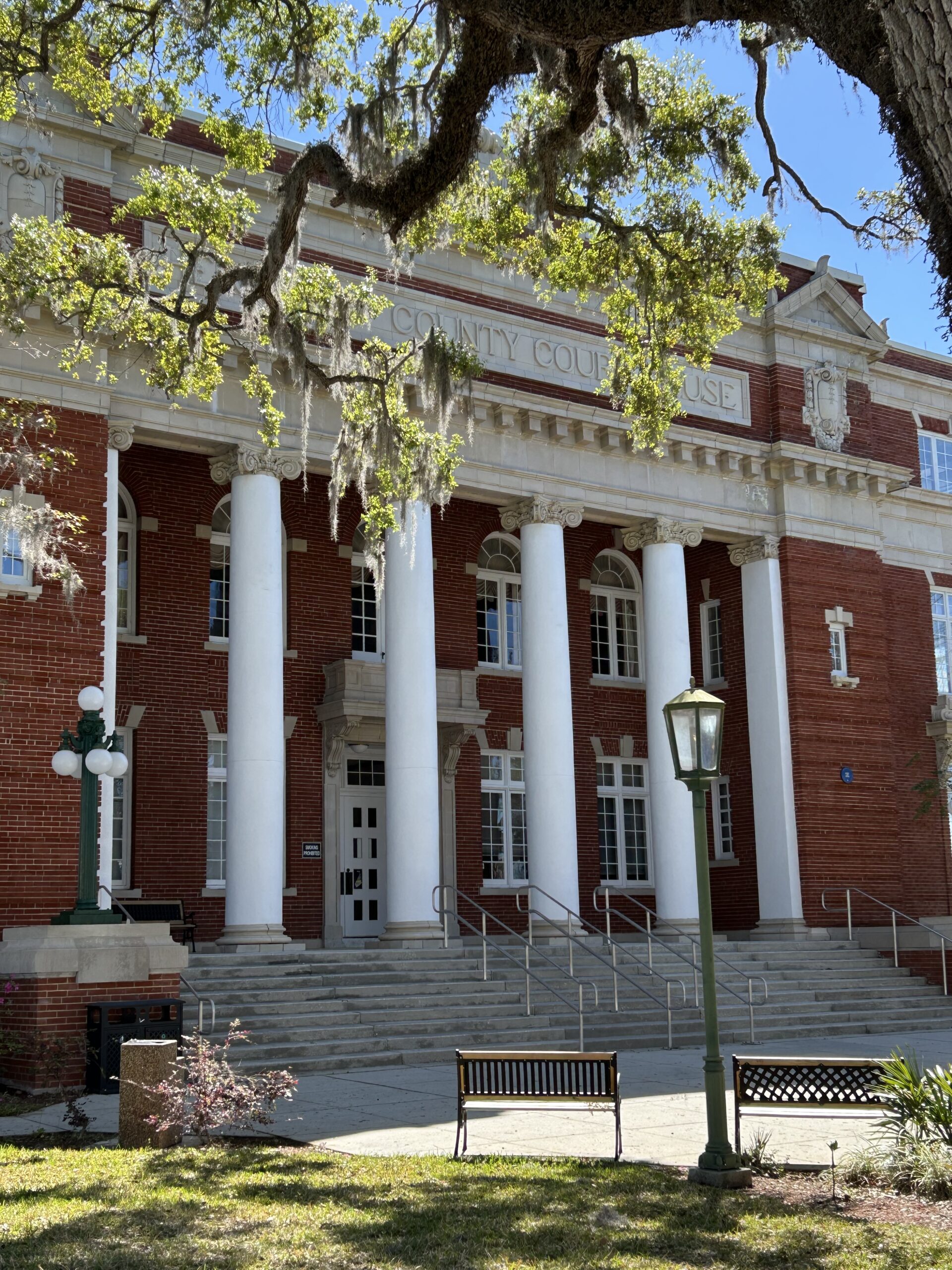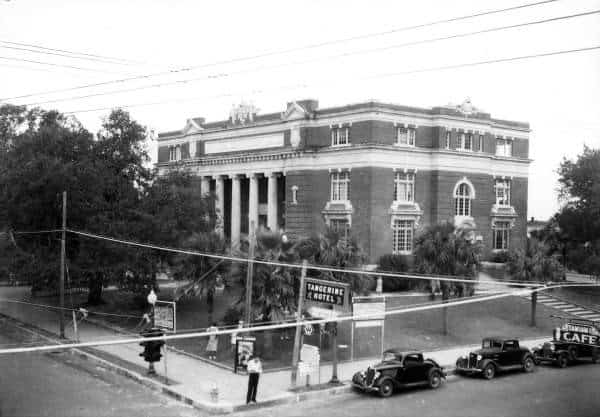By day they were farmers and citrus growers. They were successful druggists, hotel proprietors, and businessmen. Some never finished high school. Yet these same men put aside their day jobs to shape the future of Hernando County during the early 1900s. As County Commissioners they put in long hours making decisions we can appreciate today.
In 1911 William Pelham Tucker, a grove owner and farmer, became a County Commissioner. His fellow Commissioners were J. A. Jennings Sr., W.R. Ayers, J.W. Gay, and I. G. Harville. They would all play a part in having the courthouse we see in Brooksville today.
It’s hard to imagine a time without a fine brick courthouse on the town square. However early settlers had no choice but to travel miles to other counties just to conduct official business.
In 1854 state legislature declared the small port town of Bayport the Hernando County Seat. Toward the end of the Civil War, the county seat was moved permanently to Brooksville, formerly known as Melendez.
Meanwhile in 1855, Joseph Hale donated property in the center of Melendez (Brooksville) for the construction of a courthouse. In 1877 a fire destroyed the wooden building, probably a deliberate way to rid oneself of damaging court records. In 1878, a two-story replacement was constructed on the same site. A town fire brigade was established and ready to protect it.
By the early 1900s, the wooden courthouse was an unsanitary building and obsolete. There were no guidelines on what to do next. In March 1911 the Hernando County Commissioners authorized a new fire-proof brick courthouse. They budgeted $40,000-$50,000 for the project, including the furnishings. Some thought the price tag was far too low, but by today’s standards, they were asking the county for a million dollars.
In September 1911 the County Commissioners worked overtime. They met twice a week with a dozen southern architects. They reviewed numerous courthouse suggestions but nothing met with their approval.
One of the visiting architects, William A. Edwards, attended the Brooksville meetings and returned to Atlanta. He was called back by County Commissioners to submit drawings for the new courthouse. There was something about him. And surprisingly, his bid of $42,150 had been accepted at the meeting’s end after he left. Who was this man that caught the County Commissioner’s attention?
William Augustus Edwards was born on December 6, 1866, in Darlington SC. He was a contemporary of architect Frank Lloyd Wright, who was six months younger than he. At age 23 Edwards received a degree in mechanical engineering from the University of South Carolina.
Edwards first partnered with his drafting teacher Charles Coker Wilson. From 1896-1900 the two men created an astonishing fifty buildings located in parts of Florida, Georgia, Virginia, and the Carolinas. Fifty buildings in just five years! They designed banks, grammar schools, post offices, libraries, and churches.
In 1902 Edwards partnered with Frank C. Walter and soon moved the firm from South Carolina to Atlanta, Georgia. They completed six courthouses from 1903-1911. And before 1920 they would finish six more, often juggling designs and overseeing two or three courthouses at once in different states!
Work on the Hernando County Courthouse began in 1912. It was constructed in Beaux-Arts style, following classic designs of the ancient Greeks and Romans yet adding decorative touches seen in the French Renaissance. This popular architectural style began in the late 1800s and was widely used until about 1930. It was known for its grandeur and symmetry done in stone, marble, and brick. The style often displayed wide columns, long cornices, arched windows, raised entrances, and decorative touches such as stonework scrolls and crests.

[Public Domain, State Archives of Florida, Florida Memory]
The Hernando County Courthouse was completed in 1913. Four large white columns and a long set of steps with iron railings grace the main entrance. You’ll notice a wide cornice below the entire third story and a smaller cornice below the roof line. Decorative stonework touches include scrolls and crests. Upon seeing such flourishes the Hernando County Courthouse was named “Brooksville’s Crown” by Hampton Dunn in his book entitled Florida’s Historic Courthouses.
Organizing the courthouse interior took time and ran well into 1914. There were dozens of fine oak desks, chairs, and tables stacked throughout the building awaiting placement. The file cabinets hadn’t arrived and the auditorium wasn’t finished! It’s reported that county officials roamed the hallways carefully avoiding collisions with workers hanging electric lights and installing railings. It’s estimated that the courthouse interior cost $11,000, making it one of the finest and costliest of its day. Another $4,000 was allotted for sidewalks as busy visitors had trampled the grass! Roads around the courthouse were soon given serious consideration, becoming the first paved streets in Brooksville.
William A. Edwards is credited with thirteen courthouses in his lifetime. Some southern towns established in the early 1900s knew of no other courthouse building except the one done by Edwards. More than twenty-five of his buildings are listed in the National Register of Historic Places, including nine of the courthouses. His final courthouse in Fannin County, Georgia was completed in 1937, in Edward’s 70th year.
In the early 1970s, we almost lost our courthouse on the square. There was an extensive campaign to tear it down or possibly move it. The old building was showing its age, not large enough to keep up with growth.
However, the courthouse and its magnificent oak trees were saved from the wrecking ball. The County Commissioners voted to build a four-story annex just east of the existing courthouse. It would be ready for use by the summer of 1974. They also voted to permanently close a block of city street, Brooksville Avenue, between Jefferson and Broad Streets to allow continuity between the two buildings.
In 1988, a large two-story government complex was completed and attached to the historic courthouse and annex. A unique four-sided clock and some sidewalks and benches tie together the old and the new. The price tag for this contemporary building was 10.6 million dollars. And the city now owns all the way from the historic courthouse on Main Street past the government complex to the final public parking lot by Bell Avenue.
William Augustus Edwards passed away on March 30, 1939, and is buried in Columbia, South Carolina, next to his large family- his parents, spouse, and twelve siblings. This Carolina man has many connections to Florida, and not just a courthouse or two. Edwards was the architect for the Florida Board of Control from 1905-1925 and was in charge of designs for several state universities, including the University of Florida in Gainesville, Florida State University, Tallahassee, and Florida A & M, Tallahassee.
Edward’s design, Collegiate Gothic, is stamped on almost every old building you see on three Florida campuses. Most of his work goes back to the early 1900s. He designed dozens of university halls and gave them educational buildings, libraries, auditoriums and gymnasiums. Most of these buildings remain useful and stately today and are listed in the National Register of Historic Places.
Edwards has connections to Marion County north of us and to Sumter County east of us. He designed the Marion County Jail, the Ocala National Bank Building and the Post Office Building in Ocala. In 1914 he completed the Sumter County Courthouse in Bushnell, not long after putting the finishing touches on Hernando’s.
I wonder how Brooksville was able to find and cross paths with someone like William Augustus Edwards, especially that day back in 1911. Those County Commissioners/ farmers/ grove owners/ businessmen made some wise choices. It’s good to know that we still see that courthouse on the town square and that “Brooksville’s Crown” turns 112 this year.

[Photo by Judy Warnock]

